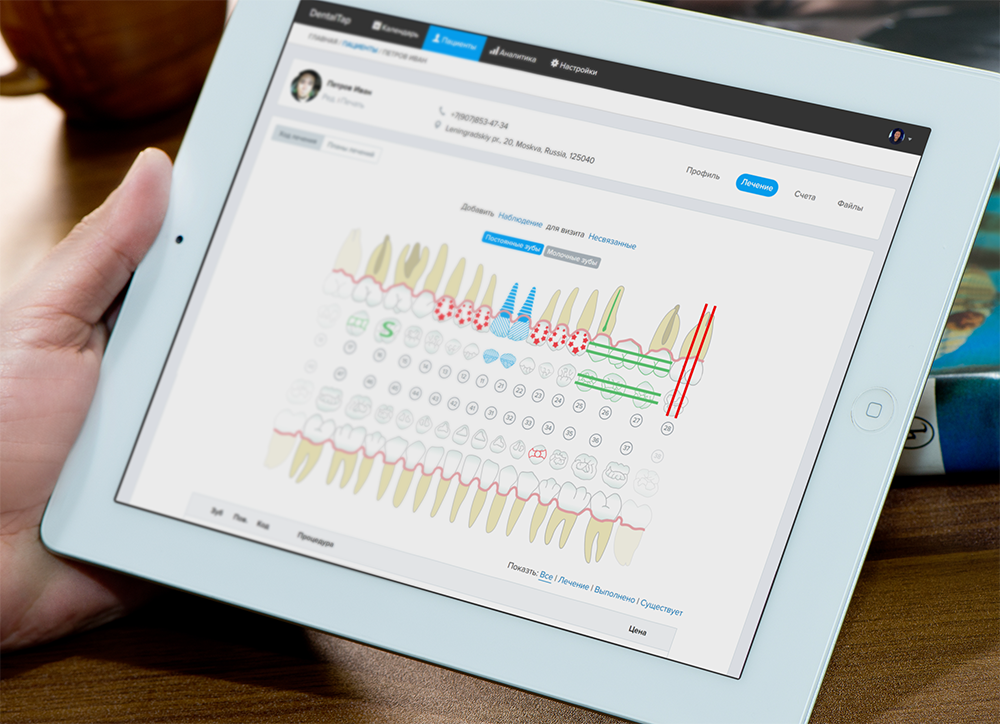DentalTap service overview - Treatment section

- Just a simple service to automate the practice of dentists?
- Not.
- Then the details, please!
In December 2016, we launched the company's second product, DentalCloud, which is focused on automating the practice of dentists. We have chosen an interesting niche in the solvent market - practicing dentists who either own their office or lead several practitioners - work in a public clinic and practice in private as an example.
Chip in what?
At the output of the development, we gave doctors full automation functionality that was previously available only to clinics and completely reworked the service architecture in the p2p direction, when the center is all about a specialist with clear tasks to automate treatment, administration, and patient communication. At the same time, we made it possible for the doctor and colleagues to work together through interesting implementations in the architecture of the solution itself. Teamwork - inviting a doctor's colleague to some stage of treatment with the transfer of all the functionality and part of the functional sections.
In fact, the architecture of DentalTap is implemented like this -
')
- The doctor works with his tenant.
- It can open the tenant at the database level for an unlimited number of users.
- A doctor can be the owner of an account (tenant) and invited to a colleague’s account.
- Tenant opens in collaboration with the ability to work with all or functionality of the service or its sections.
- The branch structure is implemented at the level of one tenant with the management of access rights from the owner's account.
- Access rights are implemented at the API entry point level.
- Separate analyst for the owner and guest account.
The advantages of this architecture:
- p2p-concept, in which the automation of the clinic and its branch structure can be made up of “cubes of personal automation”.
- Management of access rights at the level of the account owner (tenant).
- Implementation of any organizational structure of the clinic.
In the second part of the review, we will show examples of the organization of a clinic with the described architecture. In general, this approach can be implemented in any niche that holds a specialist in the center with needs for joint work - lawyers, for example.
Treatment section
DentalTap was created to close three areas of automation - the administration of a doctor’s work, treatment and communication with patients. In the first part of the review we will talk about the possibilities and functionality of treatment automation.
Dental card
- Graphic set of procedures and diagnoses for each tooth
- Dividing procedures by color - red planned, blue - completed, green existing
- Refinement of the diagnosis according to ICD-10
- Quick search and attach procedures from the price list
- Selection of tooth surfaces during restoration

Surveys
- Creating surveys and questionnaires
- Form templates
- Text answers
- The answer is "choose from options"

Treatment plans
- Binding of the plan to the patient's card
- Work with a dental card
- Choosing the type of treatment and services
- Print plan
- Binding treatment plan to schedule visits
- Coordination of the plan status "Confirmed"
Services
- Price List Categories
- Creating procedures in a category
- Category edit mode
- Multiple pricing for services
- Search procedure in the category

From the unique functionality, we offered the market an analogue of Google Form and a detailed dental formula with which you can work on mobile devices. All other opportunities for the dentist from Dentalloud in the second part of the review and meet!
Previous publications by:
» Habrahabr
» Geektimes
Source: https://habr.com/ru/post/326760/
All Articles